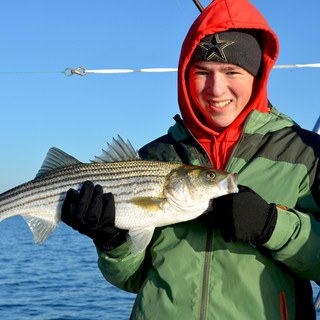Rockfish a Sportfish Staple and Still Rolling in the Potomac River and Chesapeake Bay
- By Ken Perrotte
- Dec 3, 2017
- 4 min read
Updated: Nov 9, 2020

The striped bass, locally called a “rockfish,” is arguably the most important sport fish in the Chesapeake Bay
region. The fish receive a lot of pressure with commercial anglers, charters boats and recreational fishermen plying the water when the spring spawning and late fall/early winter migrations are on. Last spring's trophy striped bass seasons in Virginia and Maryland had many anglers and charter captains lamenting an apparent lack of big fish. Boats routinely got skunked. Catching a couple keepers a day often was considered a good outing. Contrast that with what’s going on right now near the mouth of the Potomac River and the neary waters in the Bay. Good numbers of keeper-sized fish (over 20 inches) are being found. Many are between 26 and 30 inches. Anglers look for the various types of gulls, gannets and other birds diving on the water looking for the scraps that rise when the stripers are feeding below. The fish are feeding on menhaden, which is (again, arguably) the most important forage fish in the region.
Family Fishing Fun

I’ve had the good fortune to be able to head out twice since Thanksgiving, both times aboard Bob
Ackerman’s 30-foot Sport Craft. Ackerman isn’t a guide, but he fishes a lot and has a commercial hook and line license, which lets him tag and sell a few dozen fish a year. My first trip was a family outing when my brother Dana and his boys Jake and Luke were visiting. It was their first time trolling for stripers and, while it took a while to find the fish, we had enough action to scratch out a limit of two fish per person. Luke, age 11, got to crank in the largest of the day, a 34-inch beauty.
One thing standing out about the fish being caught is that they all look nice and healthy. My brother and nephews brought several pounds of beautiful fillets home.
Skippers Helping the Troops
The second trip was Dec. 2 when the tiny town of Lewisetta in Virginia’s beautiful Northern Neck hosted several wounded warriors and first responders as part of a tournament coordinated by the Quantico Injured Military Sportsmen Association.

The group coordinates expense-free outdoor experiences to wounded warriors from all services, regardless of injury or hunting and fishing background. The trips come about via the graciousness of many Americans – private citizens and businesses – who want to say “Thanks” to America’s fighting men and women and do something to let them know their service and sacrifices are appreciated.
This was the fourth year of holding the fun tournament. The guests are paired with skippers who fish from Dahlgren to Reedville. There are donated prizes for the biggest fish (this year it was a shotgun), lots of food, door prizes, raffles and more.
I got to join Ackerman’s boat. We left shortly after 6 a.m., just in time to catch a beautiful sunrise on a windless, cold morning. Ackerman worked the back of the boat, along with his usual first mate Kenny Jones. Jeff Stonehill, a longtime friend of Bob’s and a charter captain from Dahlgren, drove the boat and marked the fish on the electronics. Scott Allen, who was the guest angler, left Frederick, Maryland at 2 a.m. to get to the fishing trip. Allen served a tour in the Marines and also worked as a firefighter.

As soon as the sun started creeping into the sky, we spotted a “bird show” taking place to the east. So did almost every other boat. Stonehill gunned it toward the activity and soon after getting lines in the water, 5 of the 8 roads were slammed simultaneously. Three of the five fish were nice keepers, with two marginal. The smaller fish were released.
After that, things got a little more spotty. The highlight was when Allen pulled in a double, with one fish weighing about 10 pounds and the other just a little smaller. We pulled in for the 1 p.m. weigh-in with a full load of fish. The largest was 28 inches. The tournament’s winner was a 35-incher.There were lots of smiles around the Lewisetta Marina venue. It was obvious that the locals and the captains supporting the event derived as much satisfaction from it as the attendees.
Back to the Stripers
It is believed some 75 to 80 percent of East Coast striped bass spawn in the Chesapeake Bay tributaries. Catching big, post-spawn fish was somewhat routine until a couple years ago.
Martin Gary, executive director of the Potomac River Fisheries Commission, spent 27 years with the Maryland Department of Natural Resources and monitored stock assessments of striped bass. He said it may be some time before anglers get a crack at the numbers of big trophy fish seen a few years ago.
From 2005 to 2011, an unparalleled number of big fish were being caught, thanks to bumper crops of stripers born 1993, 1996 and 2001.
It takes about 12 years for striped bass fish to reach 35 inches in length. While the numbers of big fish aren’t around like a few years ago, Lewis Gillingham, who runs Virginia’s Saltwater Fishing Tournament says the sky isn’t falling. Current striped bass numbers “aren’t hitting triggers in the management plan that would cause a new moratorium. It’s not a dire situation like we saw in the 1970s and 1980s,” Gillingham said.
Gary said. “The stock level (of fish) seems to be doing okay, but I wonder if we’re ever going to see a situation like we had with those three record year classes. I don’t think we can count on that.”
Gary suggests people check of the Maryland DNR page that shows estimated stocks of juvenile fish, noting it’s a good predictor of how fishing might be in the years ahead. Click Here.
If you are looking for a charter captain to take you fishing on the Lower Potomac or Chesapeake, check out these three Outdoors Rambler endorsed fishing guides:























